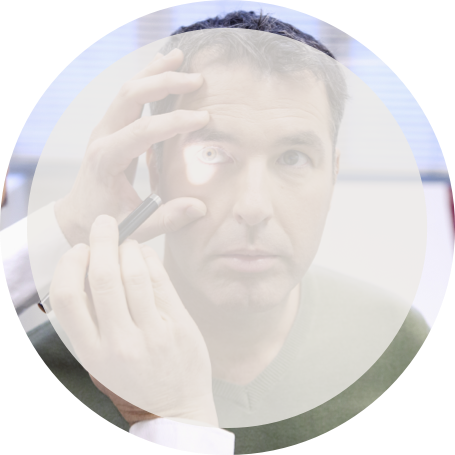Age and genetics are both primary factors for developing specific types of glaucoma. A family history of glaucoma can increase your risk of developing it yourself.
Glaucoma is a leading cause of blindness, posing significant risks to vision unless properly managed. Routine eye exams help detect issues early and preserve your sight.
What Is Glaucoma?
Glaucoma is an umbrella term for a group of eye conditions that damage the optic nerve. When left unmanaged, it can cause irreversible vision loss.
Risk Factors
Anyone can develop glaucoma, but several factors can increase risk. Many types of glaucoma may be inherited. In fact, your risk increases the more relatives you have with glaucoma. Other factors include:
- Thin corneas
- High blood pressure
- Diabetes
- Age and heritage
- High intraocular pressure (IOP)
Glaucoma & Eye Pressure
In a healthy eye, a fluid called aqueous humor nourishes the eye. Your eye constantly creates and drains this fluid to keep eye pressure stable. When the creation and drainage is interrupted, fluid can accumulate, increasing eye pressure and potentially damaging the optic nerve.
Glaucoma damage is irreversible, but permanent vision loss can be prevented with early detection and intervention.
Early Signs & Symptoms
Glaucoma won’t usually show obvious symptoms, so many people may not even know they have it.
Over time, you may experience reduced vision. Because this vision loss happens gradually, it’s hard to notice until the damage becomes too severe.
Other subtle symptoms include:
- Blurred vision
- Reduced peripheral vision
- Halos around lights
- Persistent eye discomfort
Routine eye exams are essential to detect issues that may go unnoticed otherwise. However, if you experience vision changes between visits, you should schedule an eye exam immediately to detect and address any underlying issues. It can help save your sight.
Types of Glaucoma
Open-Angle Glaucoma
This is the most common type of glaucoma, showing no warning signs in the early stages. When the eye does not drain the aqueous humor properly, the increased eye pressure starts to damage the optic nerve.
As open-angle glaucoma progresses, you may notice blind spots in your peripheral vision.
Angle-Closure Glaucoma
This type of glaucoma is less common but can occur suddenly. Angle-closure glaucoma occurs when the iris blocks the drainage angle in the eye, increasing eye pressure.
If the drainage is completely blocked, eye pressure can increase rapidly. This is considered an acute attack and is a medical emergency. It can cause blindness if not addressed immediately.
Common signs of an acute angle-closure glaucoma include:
- Sudden blurry vision
- Severe eye pain
- Headache
- Nausea
If people develop angle-closure glaucoma gradually, it’s considered chronic. Like open-angle glaucoma, it will show no symptoms at first until the damage is severe or people experience an acute attack.
Congenital Glaucoma
Although rare, some babies are born with eye problems that prevent proper fluid drainage. As a result, they develop glaucoma at birth.
Treating congenital glaucoma early can prevent permanent vision loss. If your child is born with glaucoma, you may notice signs like:
- Cloudy eyes
- Sensitivity to light
- Excess tears
Normal-Tension Glaucoma
Even with normal eye pressure, people can develop glaucoma. If your optometrist notices you have a thin optic nerve or thin corneas in the center, you may be at an increased risk of developing glaucoma.
Additionally, a family history of normal-tension glaucoma can put you at a higher risk of developing it.
Secondary Glaucoma
Glaucoma can be caused by other medical conditions, including:
- Eye pigment and iris issues
- Exfoliation syndrome
- Eye injuries
- Diabetes and high blood pressure
Like other types of glaucoma, early treatment can help prevent permanent vision loss.
How Is Glaucoma Diagnosed?

A comprehensive eye exam can help detect glaucoma. Since eye pressure often contributes to glaucoma, an eye exam may use tonometry to check your IOP.
A dilated eye exam can also help widen your pupils, allowing your optometrist to get a better look into your eye and check for signs of glaucoma. If they detect signs of glaucoma, they can create a treatment plan right away to preserve your vision.
If your optometrist determines that you don’t have glaucoma but are a “glaucoma suspect,” they may recommend scheduling check-ups more frequently to monitor your eye health.
Treatment Options
Treatment plans typically involve medication like prescription eye drops to lower the pressure in your eye and prevent further optic nerve damage.
Laser treatment is sometimes recommended to help increase fluid outflow from your eye. In some cases, your optometrist may suggest surgery to help manage glaucoma.
Your eye doctor will discuss your options and provide personalized guidance. Although optic nerve damage isn’t reversible, early treatment can help preserve your sight.
Management techniques are effective, so make sure to follow your optometrist’s advice. Schedule regular check-ups to monitor your eye health. If your treatment causes side effects, let them know right away.
If you or your family members have glaucoma, you should also encourage other family members to schedule routine eye exams. Glaucoma can run in families, so it’s important to stay proactive.
Safeguarding Your Sight
Glaucoma is known as the “silent thief of sight” since it often shows no noticeable symptoms at first. Routine eye exams can protect your vision, especially if you have relatives with glaucoma.
Contact our team at Family Vision Care today to stay proactive and preserve your eye health.
















